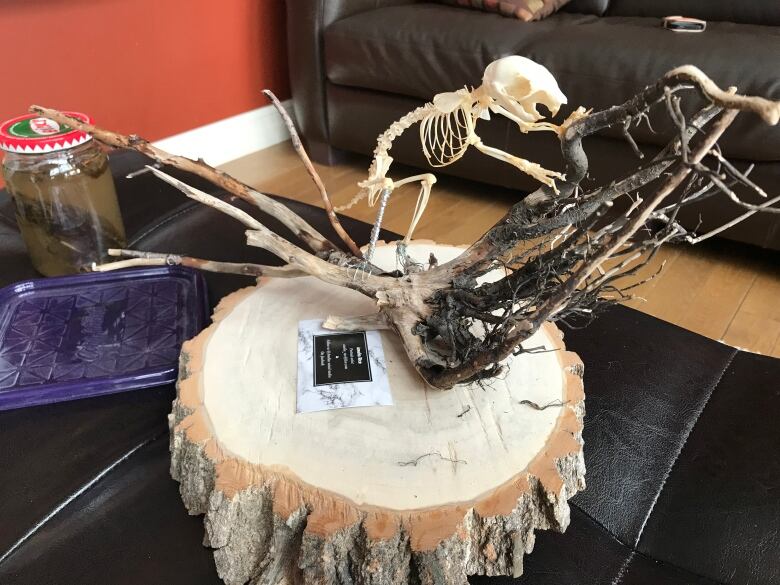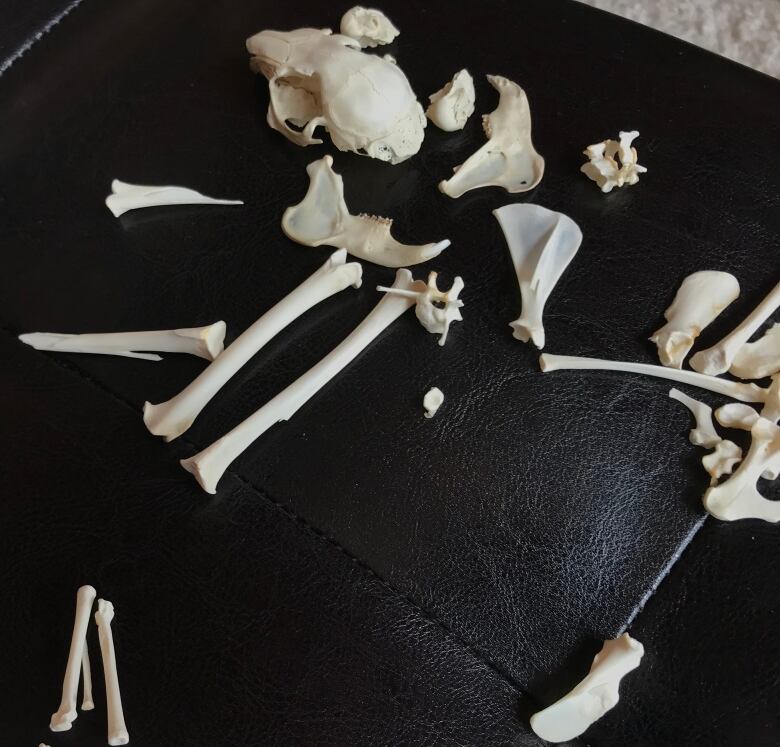Forget taxidermy this Springdale artist is preserving skeletons, not the flesh
Amelia Rice works with the bones of squirrels, rabbits, ducks and more

Taxidermy is something many are familiar with,but what about skeletal articulation?
Amelia Rice,an artist based in Springdale, sometimes uses the bones of deceased animals as a way to bring them back to life, but in a way comparable to that dinosaur standing in a local science museum.
"[Skeletal articulation]typically uses what taxidermists don't [use]. So the taxidermist will use the skins from the animal and I use the bones," the 22-year-oldtold CBC Radio's Newfoundland Morning.
"I work with squirrels andrabbits.I work with any pet animal, so snakes [and]budgie birds anything that isn't a moose, bear orcaribou."
Rice said her interest peaked while hunting with her father and running trap linesfor beavers. Her appreciation for not wasting harvested animals grew from there.
"I love to hunt. I hunt a lot of animals. I have my small game license and my big game license," she said.
"Just seeing the animals so closely, and being able to interact with them that way, really gave me a love and appreciation for the animal itself.I want to do justice to the animal and not just dispose ofparts that I think can be used."
How it's done
Rice begins by removing as much flesh and fur as possible, then placing the bones in maceration jars a technique used to obtain a clean skeleton through letting the carcass decompose in warm or cold water inside of a closed container with a constant temperature.

Rice will change the water in her jars roughly once every two weeks, leaving about 20 per cent of the previously filled water inside before adding fresh water.
"That bacteria culture will macerate the flesh and remove the remaining substances off the bone," she said.
"I have to do that around 12 times. It's quite a long process."
Once the maceration process is finished, Rice will then put the bones in a whitening jar which is simply a form of alcohol which safely whitens them.
Next, the bones are dried, layed out and put together like a puzzle.
The art
Rice said she mostly focuses on skull displays. They're easier to clean and less time consuming than an entire skeleton, despite the size of the animal, she said.
Her piecesinclude the skulls of squirrels, rabbits, ducks and even a moose, although she tries to avoid those.
"I'd wouldsay my work is pretty much budding. I'm getting alot of thingscome in. Most of them are in jars right nowand waiting to be cleaned," she said.

Rice's latest piece came from a deceased squirrel she found in the forest. She uses wire to give the animal some stability and glue to hold everything in place.
By using wire, the full squirrel is completely adjustable for posing.
Oddities community
Rice admits while it may seem like an odd passion, she says she is "not your average 22-year-old girl."
"I don't go out, and drink and all of that. I'm stopping on the road for roadkill and setting up contacts with local trappers and hunters, trying to get stuff in," Rice said.
She has even taken things a step further by contacting government just to be on the safe side of legality, though there is no law in Newfoundland and Labrador against what she's doing.

"We don't want that negative stereotype of, 'Oh, oddities people are doing things illegally,' and 'Oh,they're sketchy people.' There isno actual ruleon it in Newfoundland, other than you cannot collect large game animals," she said.
"No one has ever tried to do this in Newfoundland, and no one has ever[gone to] the government to ask 'Can I legally articulate and sell theseskeletons?' A lot of the responses I got were, 'I don't know.'"
After Rice was given the green light from government she hit the ground running.
"Seeing people's reactions, people who I never thought would be interested inskeletons coming up to me andsaying, 'I absolutely love this. This is beautiful,' it's really nice. It's rewarding," she said.
With files from Newfoundland Morning












_(720p).jpg)


 OFFICIAL HD MUSIC VIDEO.jpg)
.jpg)



























































































